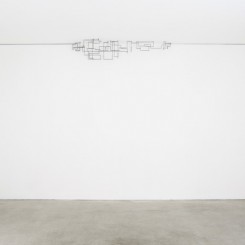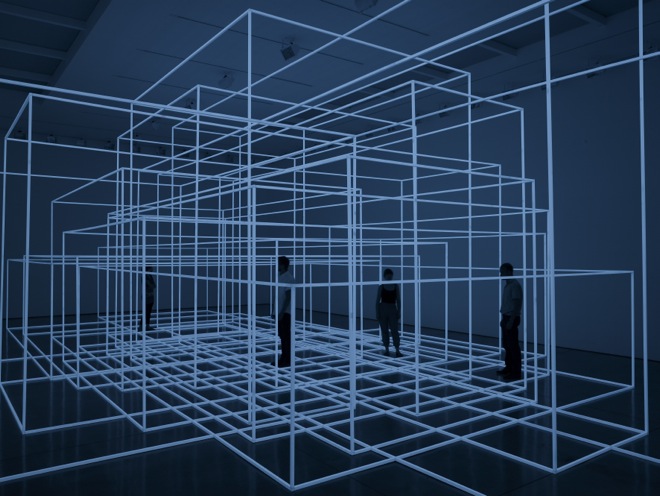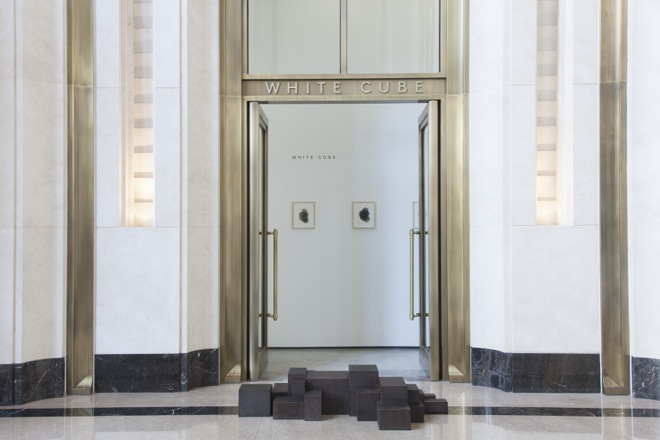Interview with Antony Gormley
Antony Gormley: “States and Conditions”, Hong Kong
White Cube (50 Connaught Road, Central, Hong Kong), March 28–May 3, 2014
Antony Gormley (b. 1950) is one of the most prominent artists of his generation, yet his work is not easily subsumed into any of the major post-War art movements. Randian spoke with Gormley about his show at White Cube Hong Kong, human microbes, Euclid, monolithic architecture, furniture and awkwardness.
Not interested in the figure
Chris Moore: The human figure is your primary medium and subject…
Antony Gormley: …I am not interested in the figure.
[CM throws away prepared questions]
AG: The figure, to me, is what has been used in Western art to tell stories. The figure assumes an understanding of anatomy. The figure is linked to a very old fashioned attitude to art training, for example, that if you don’t understand the relationship between muscle and skin, you can’t be a proper artist because you can’t give a credible reproduction of appearances back to the world. I think that’s a redundant notion of art’s purpose. Art’s purpose is not to mirror appearances and mirror the human presence as anatomy, but to inquire behind appearances and ask “How does this structure cohere, how does it come to be, what are its internal conditions?” I would replace the word “figure” with “the body”, because the body is not necessarily something known. In fact, we now know that there are close to a hundred trillion other organisms living in our bodies. As I’m speaking, there are 500 species of bacteria in my mouth. In every cubic millimeter of saliva there are hundreds of thousands of these creatures. Three kilos of my body weight are non-human cells. The body is itself an unknowable universe. I’m interested in that as a metaphor, not in its scientific sense—the body as an unknown zone. We think that we know now, having unlocked the genome, what its hereditary structure is. We are beginning to understand through microbiology some of the actions of enzymes and hormones, et cetera. But the fact is that [while] we call our bodies “my body”, they are subject to other rules.
I’m interested in re-examining this idiom that has been in some sense abused by the history of art, put to use as a vehicle for telling stories—narratives, as it were, for idealizing the appearance of things. I want to re-examine what it means for human consciousness to inhabit this unknown realm called “the body.” I want to look at the body as a possible space and not as a knowable object. In that respect, I think I’m out on my own because there are not too many other artists interested in the body as a pure space rather than as a thing that can be referred to or used. And this distinction I’m trying to make from the figure when we talk about “figurative art” is naturally associated with a whole host of assumptions about the function of art which, on the whole, I don’t agree with.
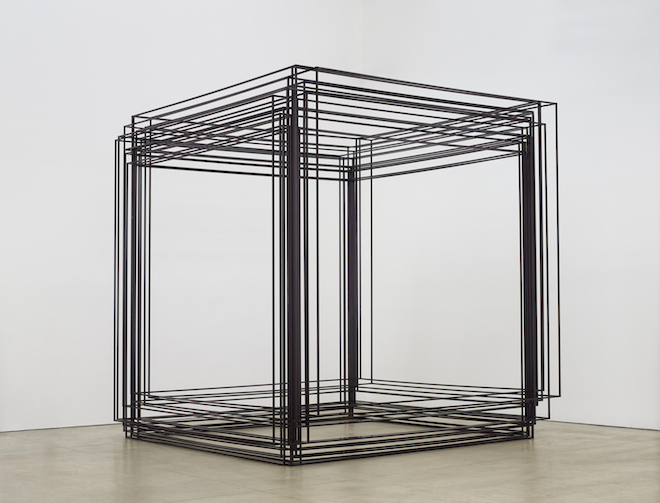
Antony Gormley, “Murmur”, stained stainless steel tube 20 x 20 mm and plastic spigots, 2014. © Antony Gormley, photograph by Stephen White, London
Boxes
CM: You talk about treating the body as a space and, in particular, a space within a space. This brings up notions of minimalism and anthropomorphism, but these are always artificial categories. For example, where does the physical leach over into the microbiotic, and how does that influence psychology and chemistry? So how do you define space in terms of these bodies that are your artworks?
AG: The most familiar way in which humans define space is to enclose it in boxes that we call rooms that aggregate into houses, that aggregate into villages, that aggregate into towns and cities. And this need to box space—to define it by enclosing it within very defined planes—we are the only species that chooses to define our habitat through the absolute rules of horizontal and vertical planes, Euclidean geometry defines our intimate habitat—[begs the question], why is it that an organic species that is part of a wider biosphere has decided to articulate —structure— its immediate, intimate environment by the most abstract rules? Well, I think that’s a good question and is at the root of most of what I do. Monolithic architecture—which I think is still the strongest expression of our relationship to matter and space and its interrelationship—depends on four basic syntactical rules: the stack, the prop, the lintel and from that, the cantilever. I am asking, what happens when you use those tectonic rules to construct a body as a spatial object? That is the root of my project—the “States and Conditions” of Hong Kong. Can we rearticulate the experience of growing within the body, using the language of the environment that shelters the body? This inversion is a way of supplanting the bone-muscle-skin anatomical understanding with the building rules of our environment. And, in the process, hopefully throwing up some intuitions about our relationship with space at large.
Testing grounds and cathedrals
AG: This show is not about putting beautiful objects into a beautiful space and hoping that people are going to buy them. It’s about trying to turn a place of spectacle into a reflective instrument—a testing ground for experience. I hope that by taking the physical space of the gallery as the primary material and catalyzing it through these inert objects, which, as I was suggesting, have their own logic of construction, somehow alters the way a viewer passes through these built spaces, and making that experience the subject and the purpose of the exhibition. So the thing that happens to people as they move through these spaces is the point of the show, not the objects.
CM: It makes me think of the way people interact with monumental architecture, going back to cathedrals. In a more precise way, you are dealing with the same issues—how does the person who is receiving this information about space in their own body, and while moving through space, react? That seems to also relate to how somebody would react to moving through a cathedral in the 13th Century.
AG: Oh, absolutely! I think that is a brilliant and useful point of reference. A cathedral is in many senses a de-functionalized architecture in which the manipulation of space itself is the theme and the motivation. And what does it do? It qualifies the small perceptual band of the human being in a space that is calculated to somehow enclose a vastness that makes us relate this man-made thing to the heavens, the sky or the perception of the infinite extension of space. I want to do exactly the same with this show, but by desacralizing it. I would like people to sense their own scale, and indeed their passage through time-space through these objects.
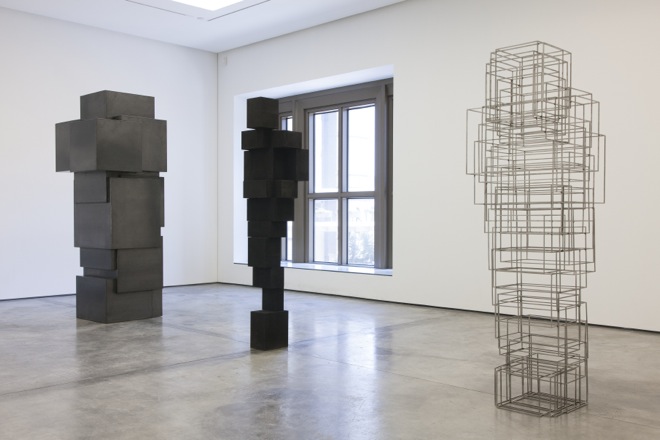
Antony Gormley, “States and Conditions”, White Cube Hong Kong, Exhibition View
安東尼‧葛姆雷,《香港:狀態與狀況》,白立方香港,展览现场
Awkward objects
AG: These objects are all in different ways quite awkward; they inhabit the world in an awkward way. The reason they do that is that they want to profit by their displacement. Their awkwardness is a conscious attempt to displace the affordances of architecture—the affordances of architecture are about making shelter, making a space that is protected from the vicissitudes of the elements. Usually, the objects that we have within it are directly related to the comfort of the body—the bed, the chair, the table—they all speak to the language of bodily continuance and support.
If you use a room barely and abstract from those “furnitures” and replace them with something that in some senses has an instrumental connection with furniture but that has a very different purpose, in other words, not to make you forget about your body by giving it ease and the possibility of rest and support—a bed, a chair, a table—but to do the opposite, to make you more aware of your body’s position in space-time, then that is going to be awkward. But it is awkward with purpose, which is to use the condition and context of an exhibition as a tool for returning ourselves to life itself. To be able to sense our mass, our speed, our relationship with the bounding conditions of our lives and hopefully—when we leave the show and go back out into the street—it has given us enough first-hand bodily experience to recalibrate our relationship with the scale of these stacked high-rise buildings and the interstitial spaces between them.
CM: I want to ask you about that experience of going out into the street, because that experience in Hong Kong is very particular.
AG: Yes, you can’t really do it without the protection of the walkways! Hong Kong—well, all cities are an ideological representation of value. We often relate to cities as givens but they are not. Cities are not givens. Since the hand-over of Hong Kong, for instance, the city has been subject to more change than ever before. The reclamation of the harbor, the push to build, is a kind of infection that has come from mainland China, and that we have seen already in Shanghai and Beijing and places like Shenzhen; I suppose that what I want the viewers to take from my exhibition is that we can look at the city itself as a representation, and we have to learn to read it. We can’t treat it as a given. We are implicated in the values that our cities represent. I think this is the big question that faces the human project: can we live sustainably at all? The city, I think, is the primary instrument for doing that. How do we see that challenge being answered in the way that we consider urbanism and the relationship between living, working and collective life, the joy of citizenship, the joy of being together with so many people? Psychologically, the intriguing thing about contemporary life is that, as human beings, we seem to want to live in higher and higher proximity but to have less and less to do with each other on a psychological level. We have to be careful about allowing the rules of the invisible hand, the market economy, to determine the conditions of this high-density living. Had “Event Horizon” happened as it was supposed to (1)—as a continuum with the show—this question of what kind of city we identify with [would have been clearer]: do we feel that cities are really ours? When we look out, do we feel that this is my body? This mixture of concrete, steel, glass—is this really part of me? —Can I feel that it is part of me!? Why is it that we have accepted a level of alienation as concomitant to high-density urban development? I don’t think we have to.
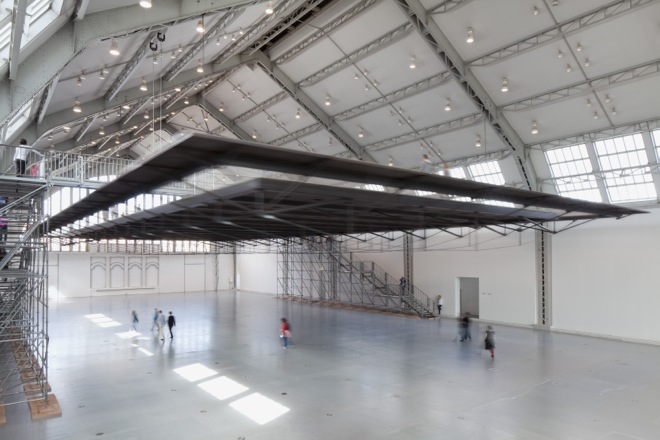
Antony Gormley, “Horizon Field Hamburg”, steel, 355 steel spiral strand cables, stainless steel mesh (safety net), wood floor, screws & PU resin for top surface coating, 206 x 2490 x 4890 cm, 67,000 kg, 2012. Photograph by Henning Rogge; © Antony Gormley
All space is provisional
CM: I would like to take a step away from this thread we’ve been discussing and consider the concept of drawing in your sculpture, such as these boxes that look like they are vibrating, or like boxes that have been hurriedly scribbled on a piece of paper with multiple lines. What is the relationship of drawing to these sculptural situations you are creating?
AG: I have to say that drawing is a way of thinking visually that is, I think, as important as walking is to moving the body. Drawing can move the mind. I try to draw every day and it is the root of my creative process. I use the language of drawing in my sculpture as well. So the things you’re talking about—there is a connection between “Breathing Room”, “Blind Light” and “Horizon Field Hamburg” and drawing; and indeed “Murmur”, the piece in this show. What I’m trying to do with those works is somehow reference—without making walls—the language of architecture in order to make it porous and somehow provisional instead of absolute. In the drawings you are talking about, which are meditations on the body as place rather than object, I’m applying this syntax of architecture but conceptually, because I’m just drawing these boxes. But what makes them interesting to me is that they are applied in an axonometric grid—they apply a kind of perspectival grid, three-quarter view to an existing structure.
What I’ve done is brought perspective back into these drawings and then extended their perspectival lines. What happens is that, far from doing what an ordinary axonometric drawings does—which is give an absolute “dimensionable” diagram of a three-dimensional object—they float in a kind of infinite grid. Broadly speaking, the implication of those drawings and a work like “Breathing Room” is that all space—all space—is provisional. All ideas of a particular place in the extended mapping of space at large is provisional. In other words, one place is as good as another. What intrigues me about those drawings is that, having identified the space through this perspectival grid, in fact you end up by liberating it—it just sort of floats in an indeterminate location—far from being pinned down, it actually begins to be liberated in space at large.
I think that’s a bit abstract. I’m not sure what anybody’s going to get out of that.
(Interview conducted by telephone with Antony Gormley at his studio, March 20, 2014)
ENDNOTES
1. “Event Horizon” is an installation consisting of 4 iron earth-bound figures which people can interact with directly, and 27 fiberglass figures, primarily unreachable, situated singly atop prominent buildings. Cast from Gormley’s own body, the figures are situated in defined urban spaces in order to draw attention to our relationships with those spaces. It was first exhibited along London’s South Bank in 2007, followed by New York’s Madison Square in 2010 and Rio de Janeiro and São Paolo in 2012. It was intended to exhibit “Event Horizon” in Hong Kong this year, coinciding with the exhibition but the installation has been postponed for organizational reasons.
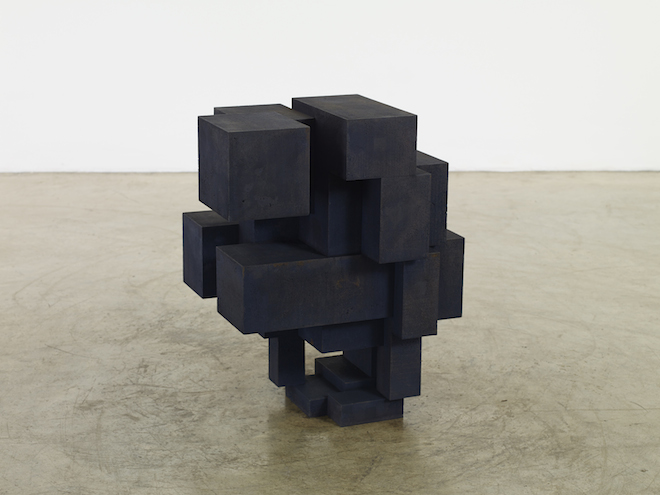
Antony Gormley, “Form”, cast iron, 73 x 55 x 63 cm, 2013. © Antony Gormley; photograph by Stephen White, London



